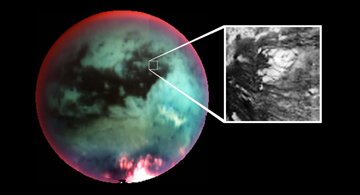 From scattered,
odd-colored in-frared images taken by the Cassini spacecraft during a flyby
of Saturn’s largest satellite, scientists have been scurrying to interpret
the features of this other world. New images are now revealing what researchers
think is evidence of a large volcano on Titan that could be erupting methane.
From scattered,
odd-colored in-frared images taken by the Cassini spacecraft during a flyby
of Saturn’s largest satellite, scientists have been scurrying to interpret
the features of this other world. New images are now revealing what researchers
think is evidence of a large volcano on Titan that could be erupting methane.From images taken aboard the Cassini spacecraft during an Oct. 26 flyby of Titan, scientists are able to see a new structure that they think could be an icy volcano, which could explain the abundance of methane in the Saturnian moon’s atmosphere. Courtesy of NASA/JPL/University of Arizona.
Through images collected during Cassini’s flyby last October at about 1,200 kilometers above the moon, researchers have seen what looks like a solid surface with topographical variations, as reported in the June 9 Nature. Infrared mapping spectrometers have penetrated through the methane-heavy haze that surrounds Titan to reveal a roughly 30-kilometer-diameter circular structure that looks to have two lobes “flowing” westward out of it. The structure appears to have a dark caldera-like feature atop it, says Christophe Sotin of the University of Nantes in France, who is lead author of the paper. Reflectance data show that the bright and dark areas are of similar composition, he says, with the brighter areas at higher altitudes.
Sotin and colleagues say that the structure — the first one seen from high-resolution images from Cassini — resembles volcanic edifices on Earth and Venus. They think it is likely a cryovolcano, an icy volcano formed by icy plumes that release methane into the atmosphere. “We just don’t have any other viable explanations so far,” Sotin says, “so we think it’s very possible this is a cryovolcano.” Other scientists, however, are more skeptical.
“It looks like it could be a volcano,” says Ralph Lorenz of the Lunar and Planetary Laboratory at the University of Arizona, Tucson, “but it also just looks like a giant cat poo. It’s very difficult to tell with this data.” It’s entirely possible though, he says, as Cassini radar instruments have already detected several other features that appear to be cryovolcanic in origin.
“I just think it may be a little too early to tell, as the images are too low in resolution,” says Louise Prockter of the Applied Physics Laboratory at Johns Hopkins University in Baltimore, Md. Features that are subcircular, such as this structure, may turn out to be impact craters like those on Venus, she says, noting how difficult it was for her team to identify evidence for cryovolcanism on Jupiter’s moon Ganymede during the Galileo mission. Sotin says the caldera-like dark area atop the structure could easily be an impact crater but doesn’t think the whole structure could be one.
But, Prockter says, for now, the researchers don’t have the resolution to tell what this structure is. “I hope it does turn out to be a volcano,” she says. “It would be the first large icy volcano in this part of the solar system.”
As Cassini continues its flybys of Titan — some 40 more are scheduled over the next couple of years — the researchers will get better images and “every dataset helps,” Sotin says. The interesting question the potential cryovolcano might answer, Sotin and colleagues say, is how Titan’s methane is replenished. As methane has a relatively short shelf-life in the atmosphere, for so much to exist, it must somehow be replaced, they say. Scientists have long thought that a large methane ocean might exist on the moon that could release methane, but have thus far not seen conclusive evidence of a large body of liquid (see below). A cryovolcano erupting methane would be a good explanation, they say.

